Conceptualization of Farmers’ Water Conservation Intention and Behavior through the Lens of Economic Man Worldview: Application of Structural Equation Modeling
Abstract
:1. Introduction
2. Materials and Methods
2.1. Research Design
2.2. Study Area
2.3. Population, Sampling, and Research Instrument
2.4. Data Analysis and Measuring Constructs
3. Results
3.1. Correlations of the Study Variables
3.2. Measurement Models’ Estimations
3.3. Estimating the Mediation Structural Model for Extended PBT
3.4. Estimation of Direct and Indirect Effects on WCB
3.5. Estimation of Fitness Indices of Extended PBT
4. Discussions and Policy Implications
5. Conclusions, Limitations, and Future Directions
Author Contributions
Funding
Data Availability Statement
Acknowledgments
Conflicts of Interest
References
- Moayedi, H.; Khasmakhi, M.A.S.A. Wildfire susceptibility mapping using two empowered machine learning algorithms. Stoch. Environ. Res. Risk Assess. 2023, 37, 49–72. [Google Scholar] [CrossRef]
- Moayedi, H.; Salari, M.; Dehrashid, A.A.; Le, B.N. Groundwater quality evaluation using hybrid model of the multi-layer perceptron combined with neural-evolutionary regression techniques: Case study of Shiraz plain. Stoch. Environ. Res. Risk Assess. 2023, 37, 2961–2976. [Google Scholar] [CrossRef]
- Yazdanpanah, M.; Hayati, D.; Thompson, M.; Zamani, G.H.; Monfared, N. Policy and plural responsiveness: Taking constructive account of the ways in which Iranian farmers think about and behave in relation to water. J. Hydrol. 2014, 514, 347–357. [Google Scholar] [CrossRef]
- Yazdanpanah, M.; Hayati, D.; Hochrainer-Stigler, S.; Zamani, G.H. Understanding farmers’ intention and behavior regarding water conservation in the Middle-East and North Africa: A case study in Iran. J. Environ. Manag. 2014, 135, 63–72. [Google Scholar] [CrossRef] [PubMed]
- Keshavarz, M.; Karami, E.; Vanclay, F. The social experience of drought in rural Iran. Land Use Policy 2013, 30, 120–129. [Google Scholar] [CrossRef]
- Veisi, K.; Bijani, M.; Abbasi, E. A human ecological analysis of water conflict in rural areas: Evidence from Iran. Glob. Ecol. Conserv. 2020, 23, E01050. [Google Scholar] [CrossRef]
- Valizadeh, N.; Bijani, M.; Karimi, H.; Naeimi, A.; Hayati, D.; Azadi, H. The effects of farmers’ place attachment and identity on water conservation moral norms and intention. Water Res. 2020, 185, 116131. [Google Scholar] [CrossRef]
- Ajzen, I. The theory of planned behavior. Organ. Behav. Hum. Decis. Process. 1991, 502, 179–211. [Google Scholar] [CrossRef]
- Bijani, M.; Hayati, D.; Azadi, H.; Tanaskovik, V.; Witlox, F. Causes and consequences of the conflict among agricultural water beneficiaries in Iran. Sustainability 2020, 12, 6630. [Google Scholar] [CrossRef]
- Stern, P. Toward a coherent theory of environmentally significant behavior. J. Soc. Issues 2000, 56, 407–424. [Google Scholar] [CrossRef]
- Kaiser, F.G. A general measure of ecological behavior1. J. Appl. Soc. Psychol. 1998, 28, 395–422. [Google Scholar] [CrossRef]
- Nigbur, D.; Lyons, E.; Uzzell, D. Attitudes, norms, identity and environmental behaviour: Using an expanded theory of planned behaviour to predict participation in a kerbside recycling programme. Br. J. Soc. Psychol. 2010, 49, 259–284. [Google Scholar] [CrossRef] [PubMed]
- Steg, L.; Vlek, C. Encouraging pro-environmental behaviour: An integrative review and research agenda. J. Environ. Psychol. 2009, 29, 309–317. [Google Scholar] [CrossRef]
- Schultz, P. New environmental theories: Empathizing with nature: The effects of perspective taking on concern for environmental issues. J. Soc. Issues 2000, 56, 391–406. [Google Scholar] [CrossRef]
- Schwartz, S.H. Normative influences on altruism1. Adv. Exp. Soc. Psychol. 1997, 10, 221–279. [Google Scholar] [CrossRef]
- Chan, L.; Bishop, B. A moral basis for recycling: Extending the theory of planned behaviour. J. Environ. Psychol. 2013, 36, 96–102. [Google Scholar] [CrossRef]
- Thøgersen, J. Recycling and morality a critical review of the literature. Environ. Behav. 1996, 28, 536–558. [Google Scholar] [CrossRef]
- Harland, P.; Staats, H.; Wilke, H.A. Situational and personality factors as direct or personal norm mediated predictors of pro-environmental behavior: Questions derived from norm-activation theory. Basic Appl. Soc. Psychol. 2007, 29, 323–334. [Google Scholar] [CrossRef]
- Simon, H.A. A behavioral model of rational choice. Q. J. Econ. 1955, 69, 99–118. [Google Scholar] [CrossRef]
- Valizadeh, N.; Bijani, M.; Abbasi, E. Farmers active participation in water conservation: Insights from a survey among farmers in southern regions of West Azerbaijan Province, Iran. J. Agric. Sci. Technol. 2018, 20, 895–910. [Google Scholar]
- Pradhananga, A.K.; Davenport, M.A.; Fulton, D.C.; Maruyama, G.M.; Current, D. An integrated moral obligation model for landowner conservation norms. Soc. Nat. Resour. 2017, 30, 212–227. [Google Scholar] [CrossRef]
- Statistical Centre of Iran. Statistical Year Book of West Azerbaijan. 2016. Available online: https://www.amar.org.ir (accessed on 18 December 2018).
- Krejcie, R.V.; Morgan, D.W. Determining sample size for research activities. Educ. Psychol. Meas. 1970, 30, 607–610. [Google Scholar] [CrossRef]
- Yazdanpanah, M.; Feyzabad, F.R.; Forouzani, M.; Mohammadzadeh, S.; Burton, R.J. Predicting farmers’ water conservation goals and behavior in Iran: A test of social cognitive theory. Land Use Policy 2015, 47, 401–407. [Google Scholar] [CrossRef]
- Dolnicar, S.; Hurlimann, A.; Grün, B. Water conservation behavior in Australia. J. Environ. Manag. 2012, 105, 44–52. [Google Scholar] [CrossRef]
- Valizadeh, N.; Bijani, M.; Abbasi, E. Farmers’ participatory-based water conservation behaviors: Evidence from Iran. Environ. Dev. Sustain. 2021, 23, 4412–4432. [Google Scholar] [CrossRef]
- Si, H.; Duan, X.; Zhang, W.; Su, Y.; Wu, G. Are you a water saver? Discovering people’s water-saving intention by extending the theory of planned behavior. J. Environ. Manag. 2022, 311, 114848. [Google Scholar] [CrossRef]
- Warner, L.A.; Diaz, J.M. Amplifying the Theory of Planned behavior with connectedness to water to inform impactful water conservation program planning and evaluation. J. Agric. Educ. Ext. 2021, 27, 229–253. [Google Scholar] [CrossRef]
- Gibson, K.E.; Lamm, A.J.; Woosnam, K.M.; Croom, D.B. Predicting intent to conserve freshwater resources using the theory of planned behavior (TPB). Water 2021, 13, 2581. [Google Scholar] [CrossRef]
- Shahangian, S.A.; Tabesh, M.; Yazdanpanah, M.; Zobeidi, T.; Raoof, M.A. Promoting the adoption of residential water conservation behaviors as a preventive policy to sustainable urban water management. J. Environ. Manag. 2022, 313, 115005. [Google Scholar] [CrossRef]
- Correia, E.; Sousa, S.; Viseu, C.; Leite, J. Using the theory of planned behavior to understand the students’ pro-environmental behavior: A case-study in a Portuguese HEI. Int. J. Sustain. High. Educ. 2022, 23, 1070–1089. [Google Scholar] [CrossRef]
- Valizadeh, N.; Jalilian, S.; Hallaj, Z.; Esfandyari Bayat, S.; Hayati, D.; Bazrafkan, K.; Kianmehr, N.; Akbari, M. Encouraging adoption of green manure technology to produce clean rice product. Sci. Rep. 2023, 13, 8690. [Google Scholar] [CrossRef] [PubMed]
- Fauzi, M.A.; Hanafiah, M.H.; Kunjuraman, V. Tourists’ intention to visit green hotels: Building on the theory of planned behaviour and the value-belief-norm theory. J. Tour. Futures 2022, in press. [CrossRef]
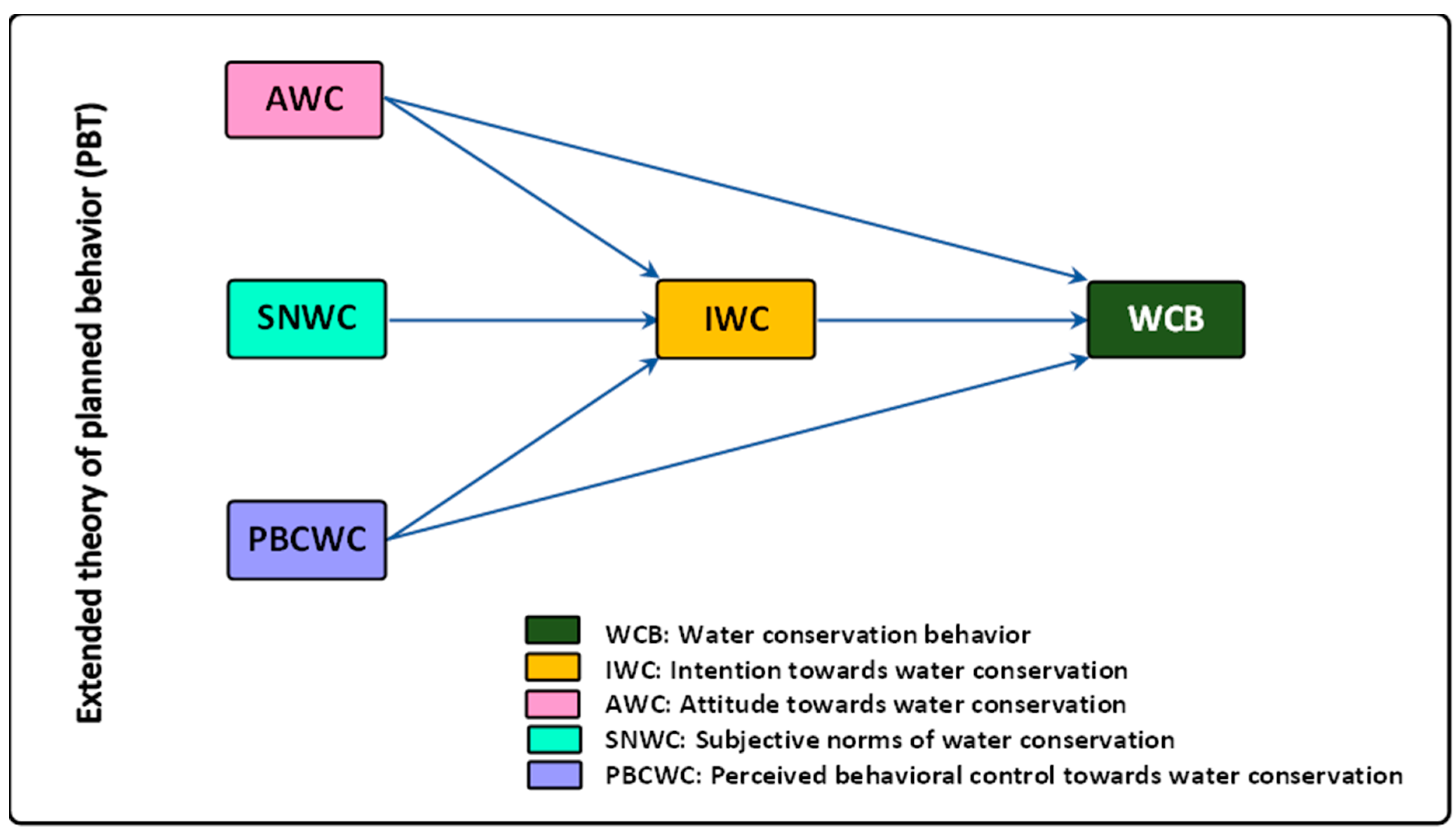
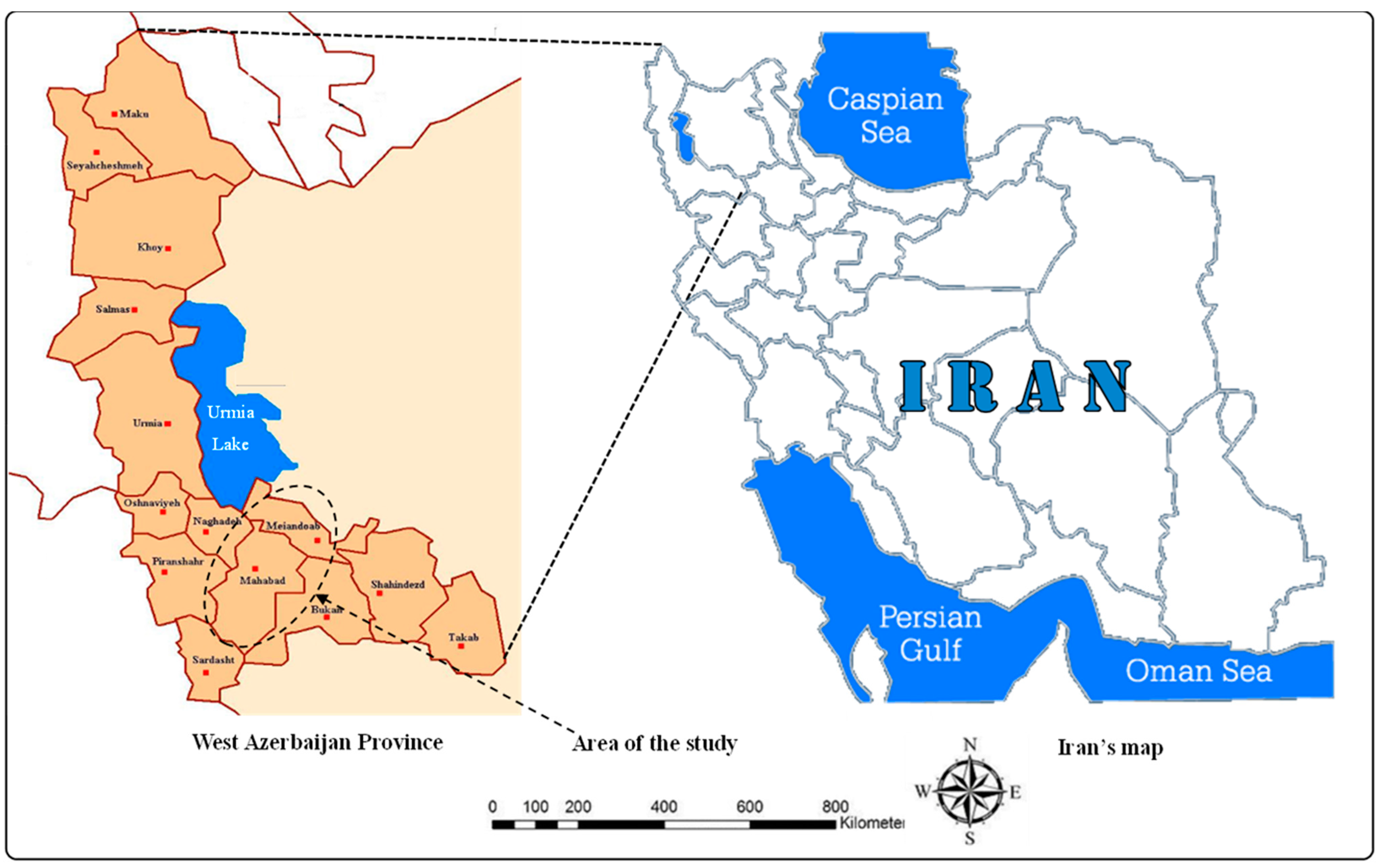
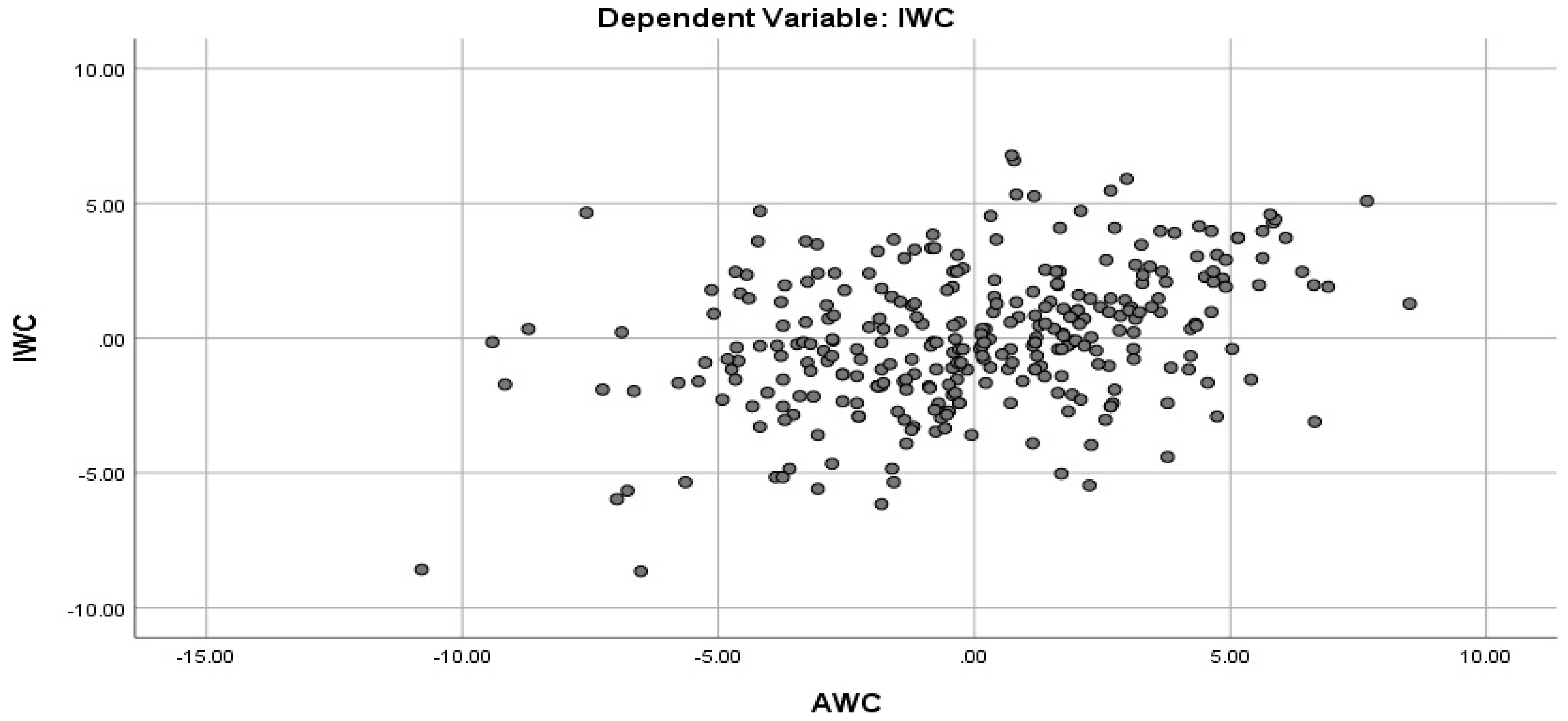
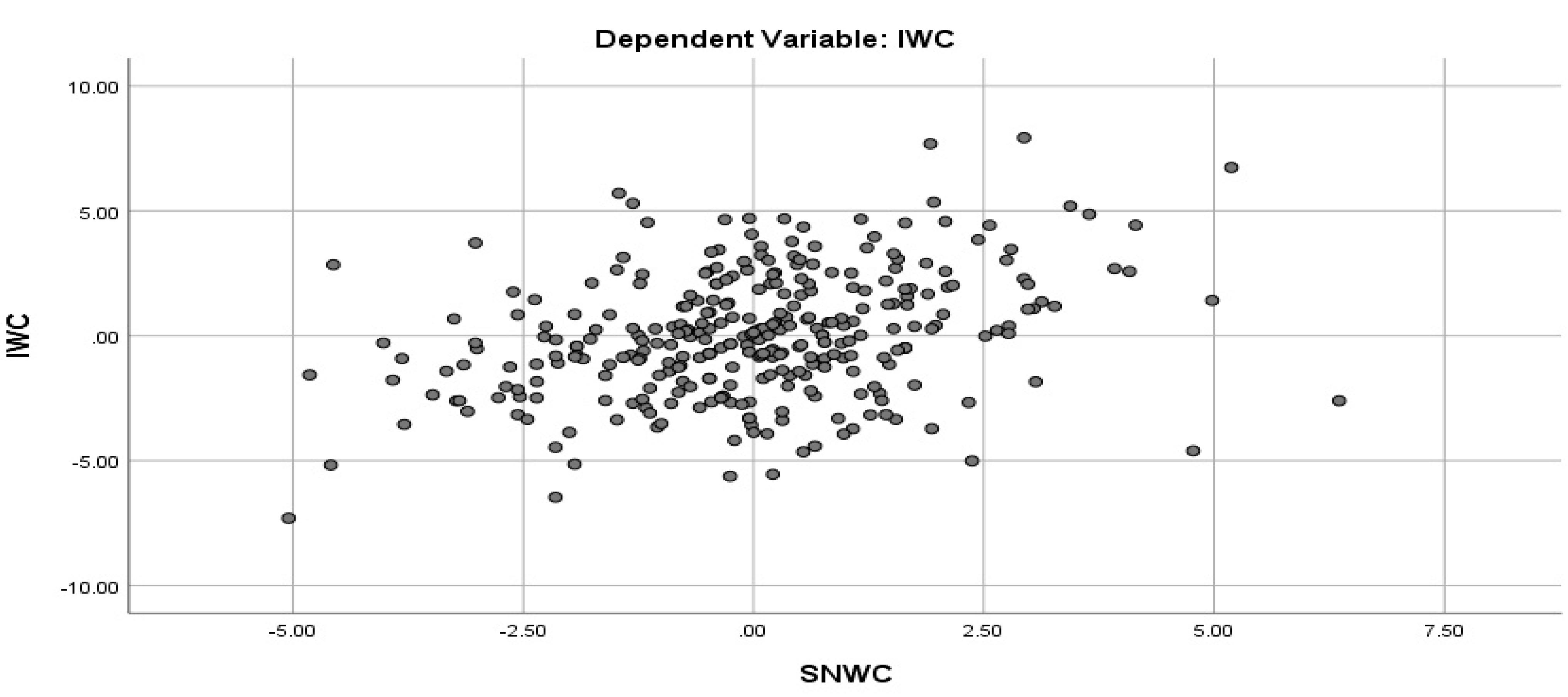
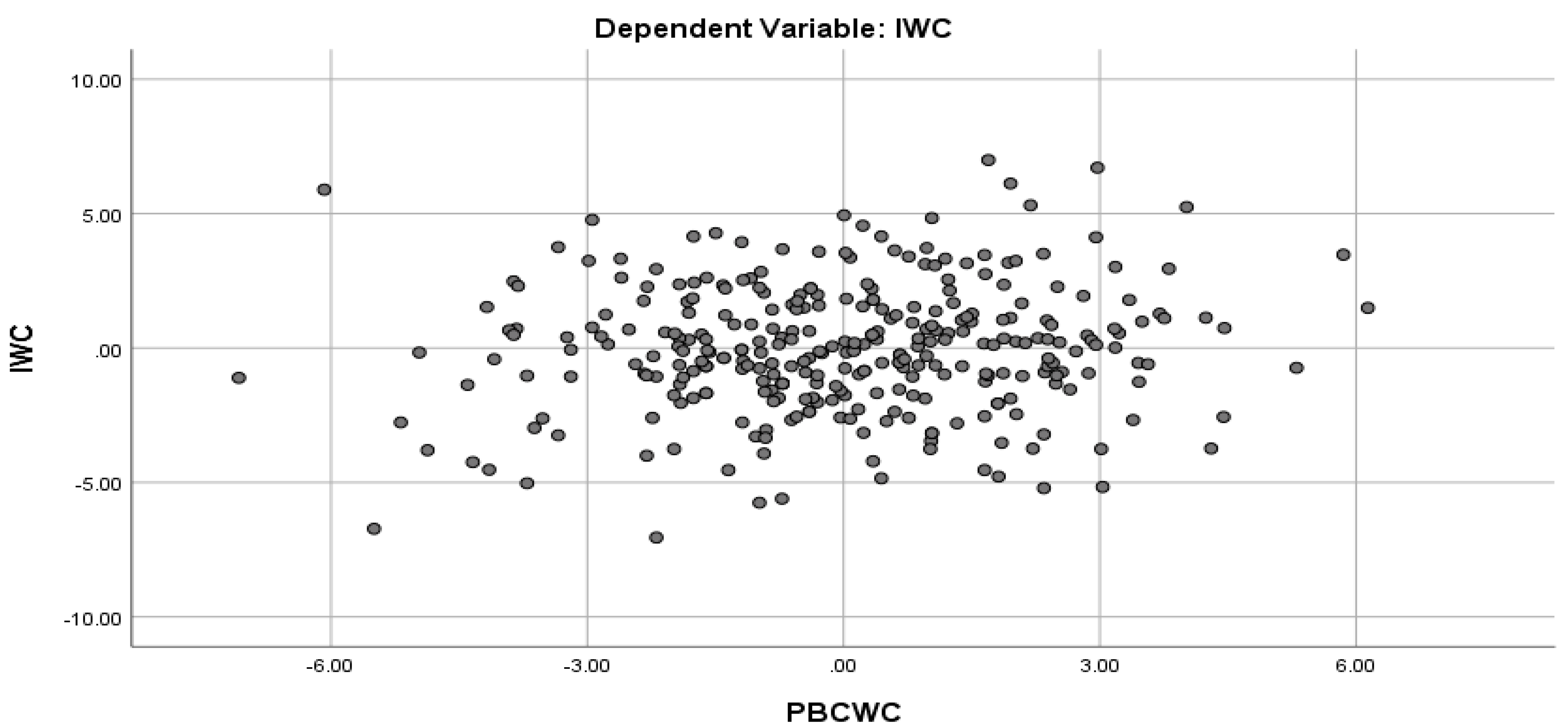
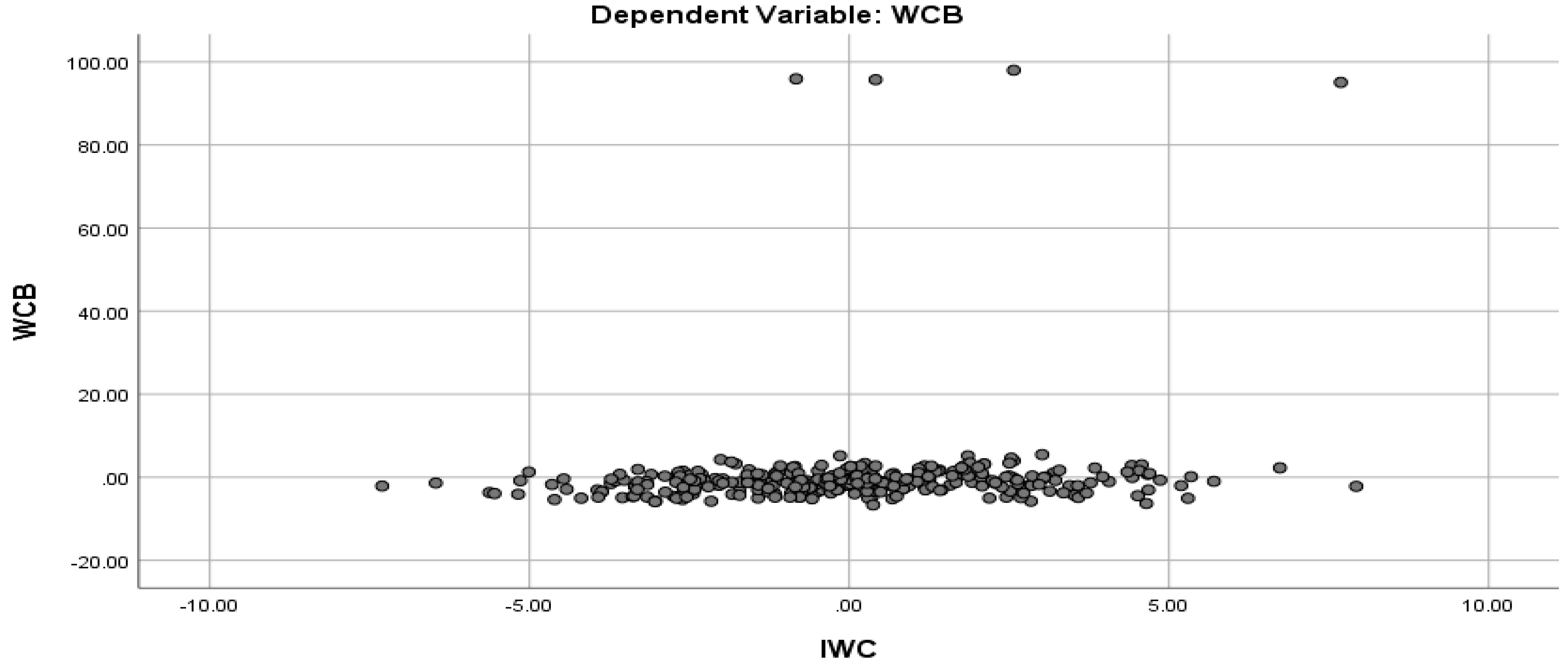
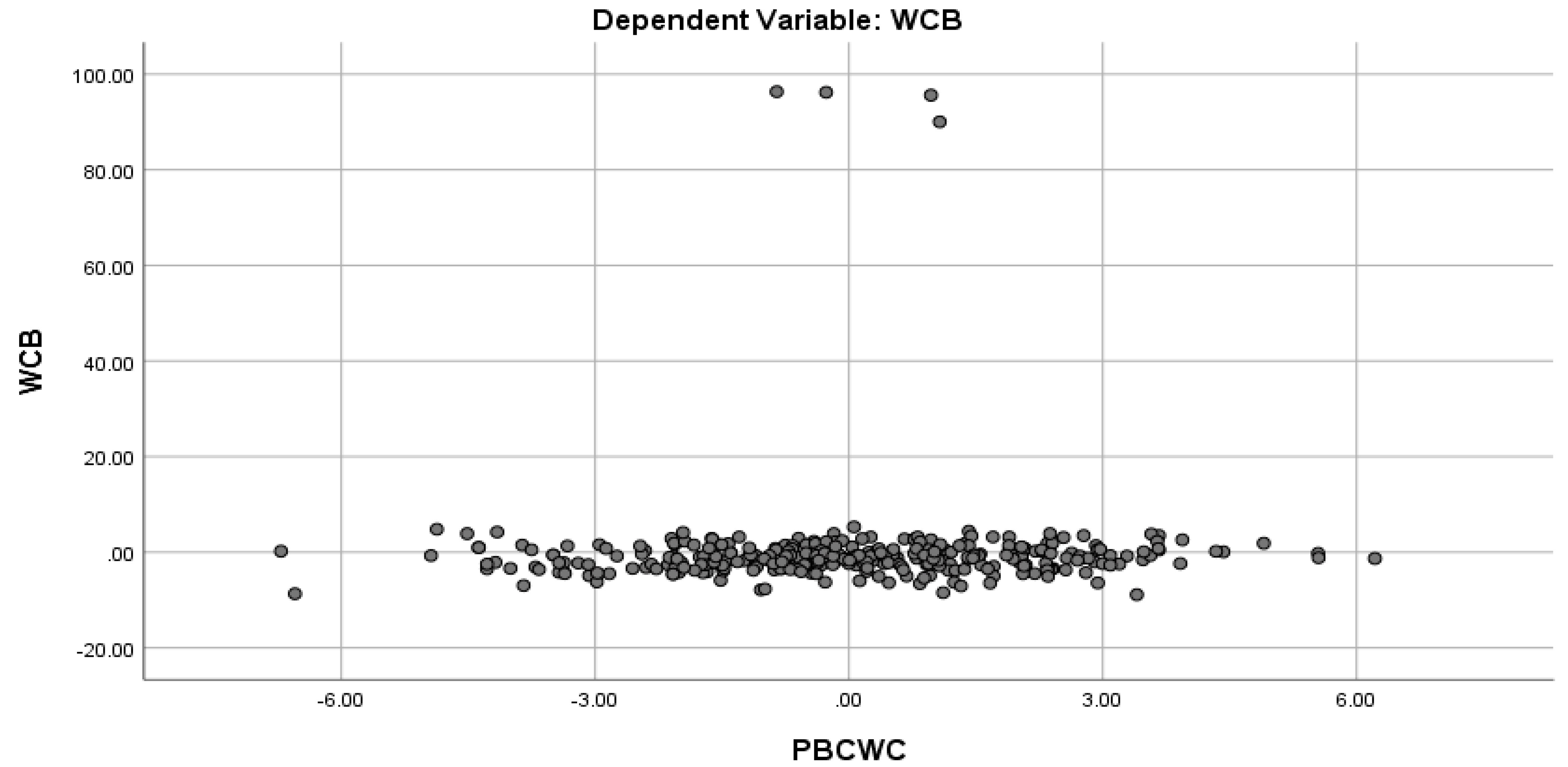
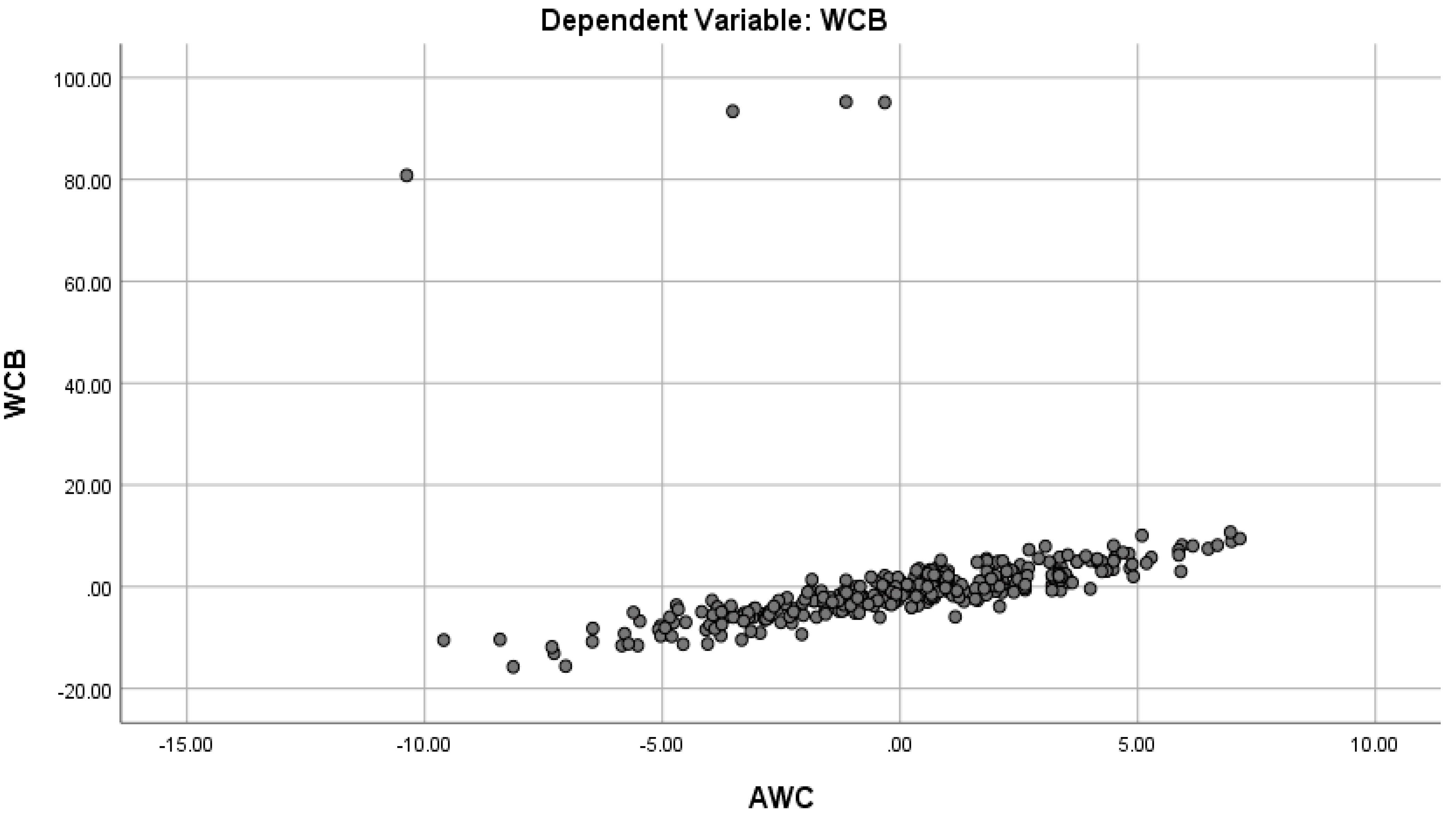
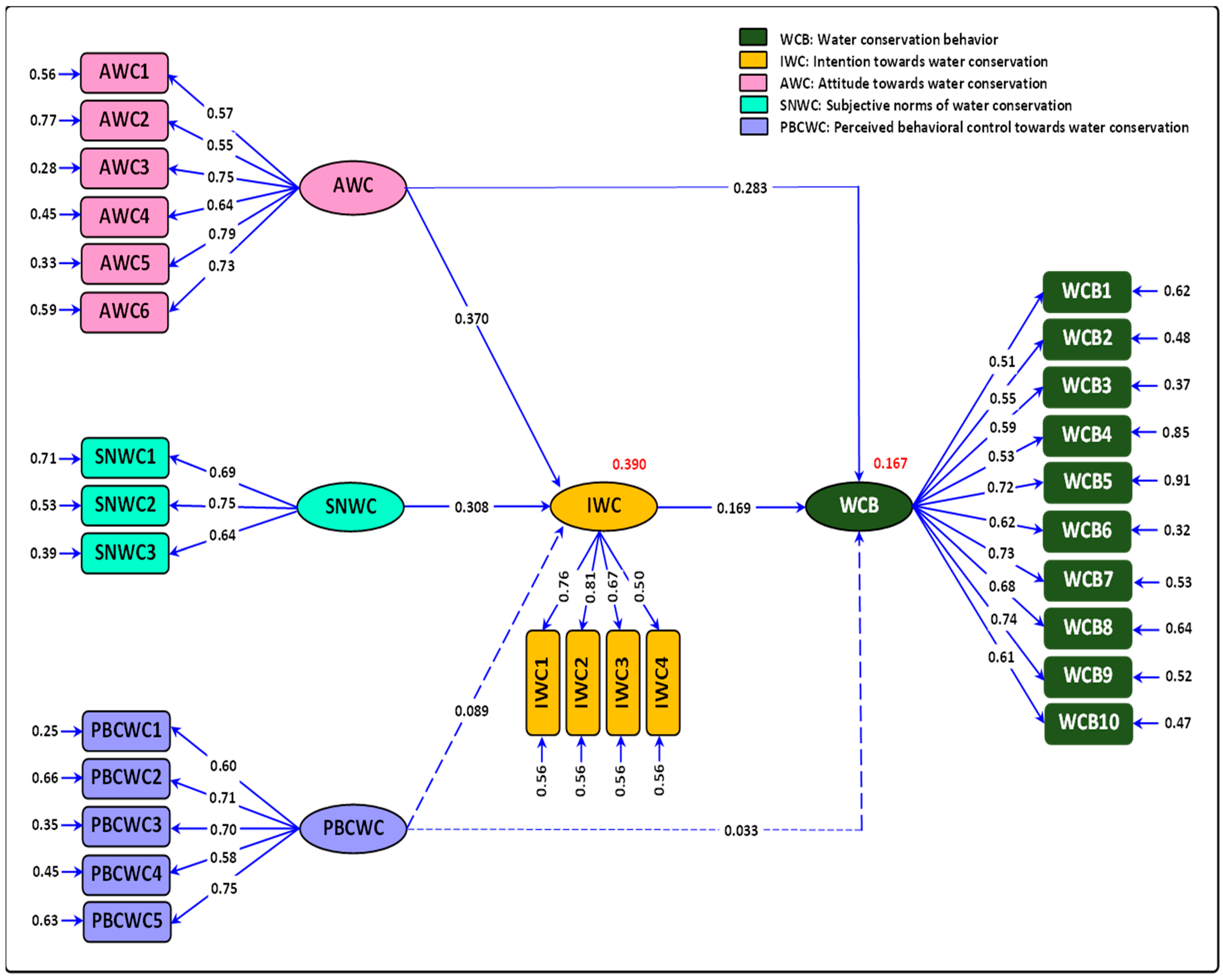
| Var. | No. | Items | Source |
|---|---|---|---|
| AWC | Attitude towards water conservation (AWC): (α = 0.73) | ||
| 1 | I think that being engaged in water protection measures is desirable. | Self-developed | |
| 2 | Perceiving water conservation as a wise action. | ||
| 3 | The usefulness of engagement in water conservation. | ||
| 4 | Prioritizing product increase over water conservation. | ||
| 5 | Necessity of saving water consumption only under water scarcity conditions. | ||
| 6 | Holding the idea that water conservation is moral. | ||
| SNWC | Subjective norms of water conservation (SNWC): (α = 0.79) | ||
| 1 | My family members, acquaintances, and friends in the village believe that I must be engaged in water protection activities. | [4] | |
| 2 | Commitment to water conservation leads to being approved by my friends and acquaintances. | ||
| 3 | I think that my acquaintances and relatives in the village expect me to be as engaged in water conservation activities as I can. | ||
| PBCWC | Perceived behavioral control over water conservation (PBCWC): (α = 0.82) | ||
| 1 | Ease of commitment to water conservation activities. | [20] | |
| 2 | I think I have the required resources including time and skills to use water protection methods. | ||
| 3 | I believe I have the economic ability to employ water protection measures. | ||
| 4 | Feasibility of water conservation on the farm. | ||
| 5 | Having the required knowledge for water conservation. | ||
| IWC | Intention towards water conservation (IWC): (α = 0.73) | ||
| 1 | Willingness to employ water protection methods. | Self-developed | |
| 2 | Willingness to pay for protecting water resources. | [24] | |
| 3 | Willingness to encourage and persuade other farmers to protect water resources. | Self-developed | |
| WCB | Water conservation behavior (WCB): (α= 0.87) | ||
| 1 | I water my land at night or in the evening. | [4,25,26] | |
| 2 | I try to repair dilapidated irrigation channels. | ||
| 3 | I usually employ methods that are considered new in irrigation field. | ||
| 4 | I usually monitor the process of irrigation on my land. | ||
| 5 | I try to avoid wasting water, and for this purpose, I use methods such as sewage recycling. | ||
| 6 | Planting drought-resistant crops. | ||
| 7 | Non-irrigation of the ground during rain. | ||
| 8 | Storing rainwater for irrigation. | ||
| 9 | I am trying to use a cover on the irrigation lines (canal) that lead to my land. | ||
| 10 | I always check the irrigation pipes for leaks before watering. | ||
| WCB | IWC | AWC | SNWC | PBCWC | |
|---|---|---|---|---|---|
| WCB | 1 | ||||
| IWC | 0.559 ** | 1 | |||
| AWC | 0.346 ** | 0.556 ** | 1 | ||
| SNWC | 0.545 * | 0.510 ** | 0.498 ** | 1 | |
| PBCWC | 0.433 ** | 0.329 ** | 0.415 ** | 0.298 ** | 1 |
| Items/Variables/Normality Measure | IWC | SNWC | PBCWC | AWC | WCB | Skew | Kurtosis |
|---|---|---|---|---|---|---|---|
| IWC1 | 0.76 * | 0.521 | 0.325 | ||||
| IWC2 | 0.81 | 0.457 | 0.459 | ||||
| IWC3 | 0.67 | −0.623 | 0.201 | ||||
| IWC4 | 0.50 | 0.321 | 0.780 | ||||
| SNWC1 | 0.69 * | 1.530 | −2.326 | ||||
| SNWC2 | 0.75 | 0.376 | 1.203 | ||||
| SNWC3 | 0.64 | 0.901 | −0.607 | ||||
| PBCWC1 | 0.60 * | 0.824 | 0.308 | ||||
| PBCWC2 | 0.71 | 0.821 | 0.171 | ||||
| PBCWC3 | 0.70 | 0.260 | 0.921 | ||||
| PBCWC4 | 0.58 | 0.389 | 0.458 | ||||
| PBCWC5 | 0.75 | −1.50 | 0.603 | ||||
| AWC1 | 0.57 * | 1.695 | −0.620 | ||||
| AWC2 | 0.55 | 0.326 | 0.985 | ||||
| AWC3 | 0.75 | 1.374 | 0.789 | ||||
| AWC4 | 0.64 | 0.238 | 0.482 | ||||
| AWC5 | 0.79 | 1.781 | 0.265 | ||||
| AWC6 | 0.73 | 0.244 | −1.550 | ||||
| WCB1 | 0.51 * | 0.308 | 0.905 | ||||
| WCB2 | 0.55 | −1.238 | 0.581 | ||||
| WCB3 | 0.59 | 0.382 | −0.398 | ||||
| WCB4 | 0.53 | 0.235 | 1.11 | ||||
| WCB5 | 0.72 | 0.865 | 0.659 | ||||
| WCB6 | 0.62 | 0.095 | −1.065 | ||||
| WCB7 | 0.73 | 0.237 | 0.691 | ||||
| WCB8 | 0.68 | 0.359 | 0.816 | ||||
| WCB9 | 0.74 | −1.330 | 0.872 | ||||
| WCB10 | 0.61 | 0.236 | 0.539 | ||||
| CR | 0.75 | 0.74 | 0.73 | 0.71 | 0.72 | - | - |
| AVE | 0.71 | 0.68 | 0.62 | 0.56 | 0.59 | - | - |
| MSV | 0.39 | 0.34 | 0.28 | 0.47 | 0.17 | - | - |
| ASV | 0.42 | 0.27 | 0.09 | 0.19 | 0.36 | - | - |
| Relationship | Estimates (Unstandardized) | Standard Error (S.E.) | Estimates (Standardized) | Significance | Result of Test |
|---|---|---|---|---|---|
| AWCIWC | 0.284 | 0.041 | 0.370 | 0.001 | Supported |
| SNWCIWC | 0.460 | 0.076 | 0.308 | 0.001 | Supported |
| PBCWCIWC | 0.113 | 0.062 | 0.089 | 0.069 | Un-supported |
| IWCWCB | 0.679 | 0.251 | 0.169 | 0.007 | Supported |
| PBCWCWCB | 0.172 | 0.292 | 0.033 | 0.557 | Un-supported |
| AWCWCB | 0.871 | 0.199 | 0.283 | 0.001 | Supported |
| Construct | Effects (Direct) | Indirect Standardized Estimates | Total (Causal Effects) |
|---|---|---|---|
| AWC | 0.283 | 0.062 | 0.345 |
| SNWC | - | 0.052 | 0.052 |
| PBCWC | 0.033 | 0.015 | 0.044 |
| IWC | 0.169 | - | 0.169 |
| Fit Index | Cut-Off | Results for Present Study |
|---|---|---|
| Adjusted goodness of fit index (AGFI) | ≥0.90 | 0.929 |
| Incremental fit index (IFI) | ≥0.90 | 0.940 |
| Comparative fit index (CFI) | ≥0.90 | 0.918 |
| Normed fit index (NFI) | ≥0.90 | 0.922 |
| Goodness of fit index (GFI) | ≥0.90 | 0.910 |
| Chi-square normalized by degrees of freedom (CMIN/DF) | ≤5 | 2.71 |
| Root mean square error of approximation (RMSEA) | ≤0.10 | 0.047 |
Disclaimer/Publisher’s Note: The statements, opinions and data contained in all publications are solely those of the individual author(s) and contributor(s) and not of MDPI and/or the editor(s). MDPI and/or the editor(s) disclaim responsibility for any injury to people or property resulting from any ideas, methods, instructions or products referred to in the content. |
© 2023 by the authors. Licensee MDPI, Basel, Switzerland. This article is an open access article distributed under the terms and conditions of the Creative Commons Attribution (CC BY) license (https://creativecommons.org/licenses/by/4.0/).
Share and Cite
Valizadeh, N.; Bijani, M.; Fallah Haghighi, N.; Hayati, D.; Bazrafkan, K.; Azadi, H. Conceptualization of Farmers’ Water Conservation Intention and Behavior through the Lens of Economic Man Worldview: Application of Structural Equation Modeling. Water 2023, 15, 3199. https://doi.org/10.3390/w15183199
Valizadeh N, Bijani M, Fallah Haghighi N, Hayati D, Bazrafkan K, Azadi H. Conceptualization of Farmers’ Water Conservation Intention and Behavior through the Lens of Economic Man Worldview: Application of Structural Equation Modeling. Water. 2023; 15(18):3199. https://doi.org/10.3390/w15183199
Chicago/Turabian StyleValizadeh, Naser, Masoud Bijani, Negin Fallah Haghighi, Dariush Hayati, Khadijeh Bazrafkan, and Hossein Azadi. 2023. "Conceptualization of Farmers’ Water Conservation Intention and Behavior through the Lens of Economic Man Worldview: Application of Structural Equation Modeling" Water 15, no. 18: 3199. https://doi.org/10.3390/w15183199









